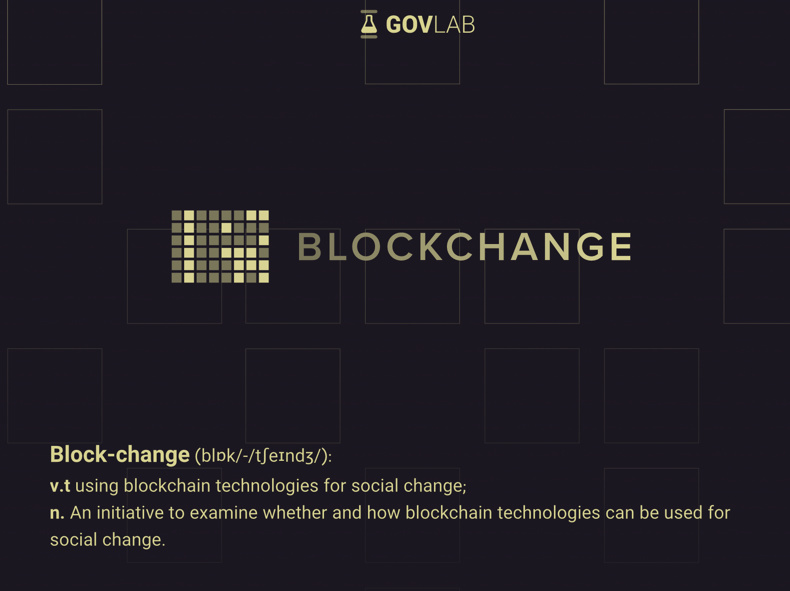سازمان شفافیت بینالملل اخیرا در مطلبی با مثالهای متعدد به رابطه شفافیت و زنجیره بلوک پرداخته است:
https://www.transparency.org/news/feature/blockchain_bitcoin_and_the_fight_against_corruption
همچنین در این گزارش نیز به بررسی این موضوع میپردازد.
سازمان شفافیت بینالملل اخیرا در مطلبی با مثالهای متعدد به رابطه شفافیت و زنجیره بلوک پرداخته است:
https://www.transparency.org/news/feature/blockchain_bitcoin_and_the_fight_against_corruption
همچنین در این گزارش نیز به بررسی این موضوع میپردازد.
گرجستان به صورت آزمایشی سامانه ی ثبت اسناد ملکی رو با استفاده بیت کوین راه انداخته است که با کمک آن جلوی ثبت اسناد جعلی و فساد رو بگیره
دو مطلب مرتبط با مزایای استفاده از زنجیره بلوک برای بخش عمومی:
در میز گردی در کنفرانس TicTec 2018 به این موضوع پرداخته شده است:

گاولب به همکاری بنیاد راکرفلر در تلاش است پتانسیلهای تکنولوژی زنجیره بلوک را برای تغییرات اجتماعی مورد مطالعه قرار دهد. در این وبسایت کلیاتی از این پروژه آمده است و در خواست ثبت مطالعات پیرامون این موضوع را داده است.
اخبار تکمیلی در همین موضوع قرار خواهد گرفت
وبسایت این پروژه
https://blockchan.ge/
Blockchain: Background and Policy Issues
Chris Jaikaran
Analyst in Cybersecurity Policy
February 28, 2018
این مطلب که به حکمرانی بلاکچین پرداخته برای کنگره آمریکا نوشته شده است
Summary
The rise of cryptocurrencies like Bitcoin and the use of Initial Coin Offerings to raise capital has
drawn increased attention from both the public and private sector concerning the use of digital
ledgers to conduct business (called blockchain technology) and its potential. Yet many remain
unclear on what the technology actually is, what it does, and the tradeoffs for its use.
A blockchain is a digital ledger that allows parties to transact without the use of a central
authority as a trusted intermediary. In this ledger, transactions are grouped together in blocks,
which are cryptographically chained together in a way that is tamper-proof and creates a
mathematically indisputable history.
Blockchain is not a new technology; rather it is an innovative way of using existing technologies.
The technologies underpinning blockchain are asymmetric key encryption, hash values, Merkle
trees, and peer-to-peer networks. Blockchain allows parties who may not trust each other to agree
on the current distribution of assets and who has those assets, so that they may conduct new
business. But, while there has been a great deal of hype concerning blockchain’s benefits, it also
has certain pitfalls that may inhibit its utility.
With blockchain, as transactions are added, the identities of the parties conducting those
transactions are verified, and the transactions themselves are verifiable by other users. The strong
relationship between identities, transactions, and the ledger enables parties that may not trust each
other or an individual computing platform to agree on the state of resources as logged in the
ledger. With that agreement, they may conduct a new transaction with a common understanding
of who has which resource and their ability to trade that resource.
Blockchain is not a panacea technology. A blockchain records events as transactions when they
happen, in the order they happen, and in an add-on only manner. Previous data on the blockchain
cannot be altered, and users of the blockchain have access to the data on the blockchain in order
to validate the distribution of resources. Though there are benefits to blockchain, there are also
pitfalls and unsolved conditions which may inhibit blockchain use. Some of those concerns are
data portability, ill-defined requirements, key security, user collusion, and user safety. As with
adopting any technology, users must examine the business, legal, and technical aspects of that
technology.
Blockchain is currently being tested by industry, but at this time does not appear to be a complete
replacement for existing systems. Although the adoption of blockchain is in its early stages,
Congress may have a role to play in several areas, including the oversight of federal agencies
seeking to use blockchain for government business, and exploration of whether regulations are
necessary to govern blockchain’s use in the private sector.
Some federal agencies are seeking to better manage identities, assets, data, and contracts through
the adoption of blockchain technology. In addition, some federal agencies are issuing guidance on
industry use of blockchain, and whether or not the current legal framework governs blockchain
use.
[center]
[/center]بلاک چین (زنجیره بلوکی) و تحولات و کاربردهای گسترده آن در حوزه_های مختلف.pdf (1.8 مگابایت)
بلاک چین (زنجیره بلوکی) و تحولات و کاربردهای گسترده آن در حوزه_های مختلف.docx (2.5 مگابایت)
نسل جدید پورتالهای داده مبتنی بر بلاکچین
Paulo Fontana, Bruna Diirr, Claudia Cappelli
Transparency in Blockchain
Blockchain is a shared ledger that provides a growing record of all transactions that have already occurred in a specific domain. It represents a series of chained blocks in which, at each block, it is possible to access: (a) structured data about transactions; (b) creation date/time; and (c) reference to its previous block. This reference allows identifying these blocks order and navigating to the first element of the blockchain. Additionally, it ensures that information is protected from adulteration because any change leads to the reference modification. Moreover, a new transaction is only added to the blockchain after being validated by all nodes in this distributed ledger network. It allows the stored information reliability, besides real-time access to all transactions (Deshpande et al, 2017; Lin & Liao, 2017). All this shows the potential of blockchain to contribute to transparency, thus allowing governmental systems to combat public resources misuse, facilitate auditing process and avoid frauds (Ølnes & Jansen, 2017; Tapscott & Tapscott, 2016).
Despite this technology simplicity and its capability of opening reliable information, new
challenges may be imposed for its effective support to transparency in democratic environments.
Moreover, it is important to understand how transparent blockchain can be. For this, an analysis of this technology was made based on the characteristics presented in Figure 1(see Table 1).
Source:
Transparency Challenges in Blockchain.pdf (764.2 کیلوبایت)
, Paulo Fontana, Bruna Diirr, Claudia Cappelli,
Proceedings of the International Conference EGOV-CeDEM-ePart 2018-(page 193-200)